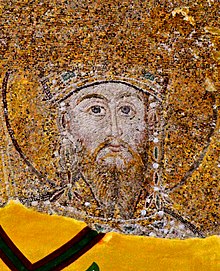
Back Johannes V Palaiologos Afrikaans Johannes V. (Byzanz) ALS Chuan V Paleologo AN يوحنا الخامس باليولوج Arabic يوحنا الخامس باليولوج ARZ بئشینجی ژان (بیزانس) AZB Іаан V Палеалог Byelorussian Йоан V Палеолог Bulgarian Joan V Paleòleg Catalan Jan V. Palaiologos Czech
This article needs additional citations for verification. (November 2023) |
| John V Palaiologos | |||||
|---|---|---|---|---|---|
| Emperor and Autocrat of the Romans | |||||
 Restored mosaic of John V Palaiologos in the eastern arch of Hagia Sophia.[1] | |||||
| Byzantine emperor | |||||
| 1st reign | 19 November 1341[2] – 12 August 1376 | ||||
| Predecessor | Andronikos III Palaiologos | ||||
| Successor | Andronikos IV Palaiologos[a] | ||||
| Co-rulers | John VI Kantakouzenos[b] Matthew Kantakouzenos[c] | ||||
| 2nd reign | 1 July 1379 – 14 April 1390 | ||||
| Successor | John VII Palaiologos | ||||
| 3rd reign | 17 September 1390 – 16 February 1391 | ||||
| Successor | Manuel II Palaiologos[d] | ||||
| Born | 18 June 1332 Didymoteicho, Byzantine Empire[3] | ||||
| Died | 16 February 1391 (aged 58) Constantinople | ||||
| Spouse | Helena Kantakouzene | ||||
| Issue |
| ||||
| |||||
| House | Palaiologos | ||||
| Father | Andronikos III Palaiologos | ||||
| Mother | Anna of Savoy | ||||
| Religion | Eastern Orthodox then converted to Eastern Catholicism | ||||
John V Palaiologos or Palaeologus (Greek: Ἰωάννης Παλαιολόγος, Iōánnēs Palaiológos; 18 June 1332 – 16 February 1391) was Byzantine emperor from 1341 to 1391, with interruptions. His long reign was marked by constant civil war, the spread of the Black Death and several military defeats to the Ottoman Turks, who rose as the dominant power of the region.
John V became emperor at age eight, which resulted in a civil war between his regent John VI Kantakouzenos and a rival council led by his mother Anna of Savoy, who pawned the crown jewels to Venice in order to raise funds. Kantakouzenos was recognized as emperor in 1347, coinciding with the arrival of the Black Death. Shortly after, another civil war erupted in 1352, with John V seeking help from Serbia against John VI's son Matthew and his enlisted Ottoman Turks. The Turks used the ensuing chaos to gain their first European territory on former Byzantine soil.
John V assumed real power in 1354, removing John VI and his son Matthew. He attempted to gain Western support for the war against the Turks, resulting in his conversion to Catholicism in 1369 in presence of the Pope. These efforts were useless, as he was imprisoned in Venice due to his debts and was eventually forced to recognize Ottoman suzerainty. Political intriguing continued to plague his late reign; John was twice usurped from the throne, first by his son Andronikos IV in 1376 and then by his grandson John VII in 1390. He died in 1391 and was succeeded by his son Manuel, while his younger son Theodore ruled the Despotate of the Morea.
- ^ Necipoğlu, Nerva (2001). Byzantine Constantinople: Monuments, Topography and Everyday Life. Brill. p. 226. ISBN 9004116257.
This mosaic, known to us from drawings prepared by the Fossatis during their restoration of the building in 1847–1849, accidentally came to light when part of the plaster covering it fell off due to dampness caused by water leakage from the dome.
- ^ Prosopographisches Lexikon der Palaiologenzeit, "Palaiologos Ioannes V. Komnenos"
- ^ Επίτομο Γεωγραφικό Λεξικό της Ελλάδος (Geographical Dictionary of Greece), Μιχαήλ Σταματελάτος, Φωτεινή Βάμβα-Σταματελάτου, εκδ. Ερμής, ΑΘήνα 2001
Cite error: There are <ref group=lower-alpha> tags or {{efn}} templates on this page, but the references will not show without a {{reflist|group=lower-alpha}} template or {{notelist}} template (see the help page).
© MMXXIII Rich X Search. We shall prevail. All rights reserved. Rich X Search